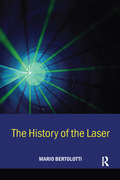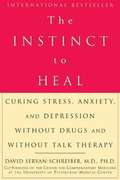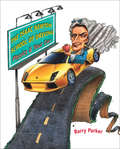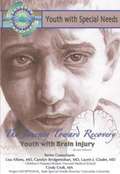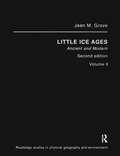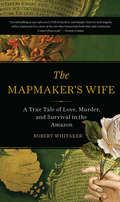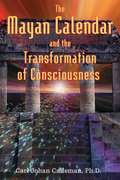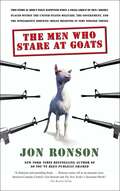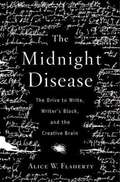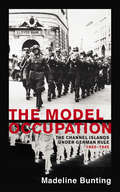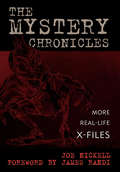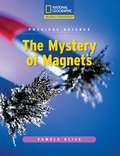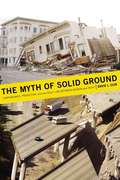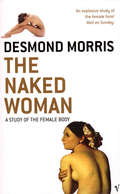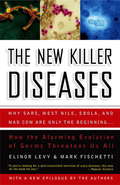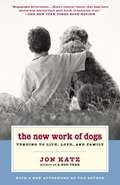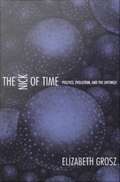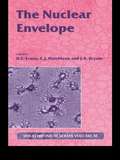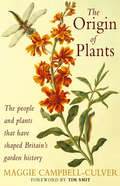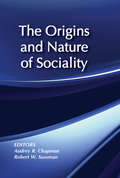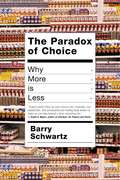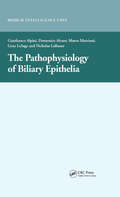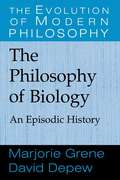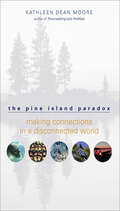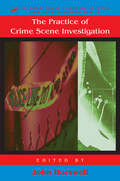- Table View
- List View
The History of the Laser
by Mario BertolottiSince the invention of the first working laser in 1960, development of these devices has progressed at an unprecedented rate, to the extent that the laser is now a common part of everyday life, from the semiconductor laser used in CD players and telecommunication systems to the high power eximer lasers used in manufacturing processes. This book tra
The Instinct to Heal: Curing Stress, Anxiety, and Depression without Drugs and Without Talk Therapy
by David Servan-SchreiberRecent discoveries about the emotional brain show we can heal naturally from stress and depression. Award-winning psychiatrist and neuroscientist David Servan-Schreiber, M.D., Ph.D., presents seven methods for faster, more dramatic, and permanent results for patients who want to leave suffering behind and live joyful, happy lives.<P> The methods presented in this book, taken from case histories, have all been proven to work in clinical tests. They are based on the self-healing mechanisms of the emotional brain, which controls the body, as opposed to the cognitive brain, which manipulates symbols and language. Dr. Servan-Schreiber considers the influence of the heart upon the brain, explores the use of EMDR (eye-movement desensitization and reprocessing) to recover from trauma, and explains how to reset your biological clock to avoid symptoms from seasonal depression.<P> We learn how the biochemistry of touch and love can heal emotional wounds, and we also learn how to use acupuncture, nutrition, and exercise to control our moods. An international bestseller, this is the first book on the market to answer the public's questions about the new alternatives to conventional psychopharmaceuticals, as well as traditional talk therapy. By reprogramming their emotional brains, people struggling with stress, anxiety, and depression can rediscover the balance and well-being needed to transform their lives.
The Isaac Newton School of Driving: Physics and Your Car
by Barry ParkerFor some people, driving is an art; for others, it's a science. At the Isaac Newton School of Driving, though, every car is a laboratory on wheels and every drive an exciting journey into the world of physics. As explained by renowned science writer and physics professor Barry Parker—whose father was a car mechanic and garage owner—almost every aspect of driving involves physics. A car's performance and handling relies on fundamental concepts such as force, momentum, and energy. Its ignition system depends on the principles of electricity and magnetism. Braking relies on friction—yet another basic scientific concept—and if the brakes fail, the resulting damage, too, can be predicted using physics.Parker's first lesson describes the basic physics of driving: speed and acceleration; why you get thrown forward while braking or outward while turning; and why car advertisements boast about horsepower and torque. He goes on to discuss the thermodynamics of engines, and how they can be more fuel efficient; and what friction and traction are and how they keep a car's tires on the road, whether it's dry, wet, or icy. He also describes how simple laws of physics enable scientists to design aerodynamic cars and high-tech steering systems. Parker then explores the high-performance physics of auto racing, outlines how traffic accidents are reconstructed by police, uses chaos theory to explain why traffic jams happen, and describes what cars of the future might look like. Whether you drive a Pacer or a Porsche, The Isaac Newton School of Driving offers better—and better-informed—driving through physics.
The Journey Toward Recovery: Youth with Brain Injury (Youth with Special Needs)
by Joan EsherickJerome pedaled down the mountain, his friends Tommy and Eric racing to catch up. The wide, flat path was made for smooth riding, but Jerome's mind wasn't on the trail. A sudden rustling in the brush ahead startled him out of his daydreaming. A dog darted out of the shrubs, then stopped dead in the trail. The next several seconds seemed to pass in slow motion. Jerome squeezed hard on the hand brakes, but it was too late. His front wheel collided with the animal; the dog yelped; and Jerome somersaulted over his handlebars. Tommy said later he would never forget how his friend flew through the air and collided head-on with the sycamore tree. Eric said he'd never forget the sickening thud the impact made. But what his friends would never forget, Jerome would never remember. In a brilliant white flash, Jerome's life as he knew it was gone. What do bikes, cars, scooters, sports, tumors, strokes, guns, and the shaking of babies all have in common? They all can cause brain injuries. Every twenty-one seconds, one person in the United States sustains a traumatic brain injury. In The Journey Toward Recovery: Youth with Brain Injury you will read about Jerome, one teen who finds his life changed forever in a split-second accident. Along the way, you will also learn about other forms of brain injury; how these injuries affect people's lives; and how schools, doctors, and lawmakers are helping youth with this form of special need.
The Little Ice Age: Ancient And Modern (Routledge Studies In Physical Geography Ser. #Vol. 5)
by Jean M. GroveThe evidence for the Little Ice Age, the most important fluctuation in global climate in historical times, is most dramatically represented by the advance of mountain glaciers in the sixteenth and seventeenth centuries and their retreat since about 1850. The effects on the landscape and the daily life of people have been particularly apparent in Norway and the Alps. This major book places an extensive body of material relating to Europe, in the form of documentary evidence of the history of the glaciers, their portrayal in paintings and maps, and measurements made by scientists and others, within a global perspective. It shows that the glacial history of mountain regions all over the world displays a similar pattern of climatic events. Furthermore, fluctuations on a comparable scale have occurred at intervals of a millennium or two throughout the last ten thousand years since the ice caps of North America and northwest Europe melted away. This is the first scholarly work devoted to the Little Ice Age, by an author whose research experience of the subject has been extensive. This book includes large numbers of maps, diagrams and photographs, many not published elsewhere, and very full bibliographies. It is a definitive work on the subject, and an excellent focus for the work of economic and social historians as well as glaciologists, climatologists, geographers, and specialists in mountain environment.
The Mapmaker's Wife: A True Tale Of Love, Murder, And Survival In The Amazon
by Robert WhitakerIn 1735 a team of French scientists set out on a daring expedition into the South American wilderness to resolve one of the great scientific challenges of the time: the precise size and shape of the Earth. Scaling the Andes and journeying along the Amazon, the mapmakers faced all manner of danger, while madness, disease and violent death each took their toll. However one, Jean Godin, fell in love with a local girl called Isabel Grameson. When the time came for the expedition to return to France, Godin travelled ahead to ensure the way was safe for his new family. But on reaching French Guiana, disaster struck: Spain and Portugal closed their borders and he was stranded, unable to return to Isabel. What followed lies at the core of this extraordinary tale - a heartbreaking 20-year separation that ended when Isabel, believing she might never see her husband again, decided to make her own way across the continent: a journey that began in hope but became hell on earth. . . Drawing on his own experience retracing Isabel's epic trek as well as contemporary records, Robert Whitaker recounts a captivating true story of love and survival set against the backdrop of what many still regard as 'the greatest expedition the world has ever known'.
The Mayan Calendar and the Transformation of Consciousness
by Carl Johan CallemanReveals the Mayan calendar to be a spiritual device that describes the evolution of human consciousness from ancient times into the future• Shows the connection between cosmic evolution and actual human history• Provides a new science of time that explains why time not only seems to be speeding up in the modern world but is actually getting faster• Explains how the end of the Mayan calendar is not the end of the world, but a path toward enlightenmentThe prophetic Mayan calendar is not keyed to the movement of planetary bodies. Instead, it functions as a metaphysical map of the evolution of consciousness and records how spiritual time flows--providing a new science of time.The calendar is associated with nine creation cycles, which represent nine levels of consciousness or Underworlds on the Mayan cosmic pyramid. Through empirical research Calleman shows how this pyramidal structure of the development of consciousness can explain things as disparate as the common origin of world religions and the modern complaint that time seems to be moving faster. Time, in fact, is speeding up as we transition from the materialist Planetary Underworld of time that governs us today to a new and higher frequency of consciousness--the Galactic Underworld--in preparation for the final Universal level of conscious enlightenment. Calleman reveals how the Mayan calendar is a spiritual device that enables a greater understanding of the nature of conscious evolution throughout human history and the concrete steps we can take to align ourselves with this growth toward enlightenment.
The Men Who Stare at Goats
by Jon RonsonBizarre military history: In 1979, a crack commando unit was established by the most gifted minds within the U.S. Army. Defying all known laws of physics and accepted military practice, they believed that a soldier could adopt the cloak of invisibility, pass cleanly through walls, and--perhaps most chillingly--kill goats just by staring at them. They were the First Earth Battalion, entrusted with defending America from all known adversaries. And they really weren't joking. What's more, they're back--and they're fighting the War on Terror. An uproarious exploration of American military paranoia: With investigations ranging from the mysterious "Goat Lab," to Uri Geller's covert psychic work with the CIA, to the increasingly bizarre role played by a succession of U.S. presidents, this might just be the funniest, most unsettling book you will ever read--if only because it is all true and is still happening today.
The Midnight Disease: The Drive to Write, Writer's Block, and the Creative Brain
by Alice Weaver FlahertyNeurologist Flaherty (Massachusetts General Hospital and Harvard Medical School) explains the psychological and neuroscientific knowledge about the process of writing for a lay audience. She discusses the temporal lobe's role in "abnormal hypergraphia," an increased desire to write. She then explores psychological and neurological explanations for writer's block. The roles of the cerebral cortex in writing ability, the limbic system in the drive to communication, and the temporal lob in metaphorical thinking are examined in subsequent chapters. Annotation ©2004 Book News, Inc. , Portland, OR (booknews. com)
The Model Occupation: The Channel Islands Under German Rule, 1940-1945
by Madeleine Bunting‘A masterly work of profound research and reflection, objective and humane’ Hugh Trevor-Roper, Sunday TelegraphWhat would have happened if the Nazis had invaded Britain? How would the British people have responded – with resistance or collaboration? In Madeleine Bunting’s pioneering study, we begin to find the answers to this age-old question.Though rarely remembered today, the Nazis occupied the British Channel Islands for much of the Second World War. In piecing together the fragments left behind – from the love affairs between island women and German soldiers, the betrayals and black marketeering, to the individual acts of resistance – Madeleine Bunting has brought this uncomfortable episode of British history into full view with spellbinding clarity.
The Mystery Chronicles: More Real-Life X-Files
by Joe Nickell&“Science-based explanations for unusual happenings [and] documented solutions for more than three dozen mysteries.&” ―Dallas Morning News Investigator Joe Nickell has spent over thirty years solving the world&’s most perplexing mysteries. This new casebook reveals the secrets of the Winchester Mystery House, the giant Nazca drawings of Peru, the Shroud of Turin, the &“Mothman&” enigma, the Amityville Horror house, the vicious goat-sucking El Chupacabra, and many other &“unexplainable&” phenomena. Nickell has traveled far and wide to solve cases, which include a weeping icon in Russia, the elusive Bigfoot-like &“yowie&” in Australia, the reputed power of a headless saint in Spain, and an &“alien hybrid&” in Germany. He has gone undercover—often in disguise—to reveal the tricks of those who pretend to talk to the dead; accompanied a Cajun guide into a Louisiana swamp in search of a fabled monster; and gained an audience with a voodoo queen. Superstar psychic medium John Edward, pet psychic Sonya Fitzpatrick, evangelist and healer Benny Hinn, and many other well-known figures have found themselves under Nickell&’s careful scrutiny. The Mystery Chronicles examines more than three dozen intriguing mysteries, as Nickell uses a hands-on approach and the scientific method to steer between the extremes of mystery mongering and debunking. With a foreword by James Randi &“His varied work experience as a private investigator, forensic document analyst, stage magician, carnival pitchman, and English professor gives him credibility as a hard-nosed researcher and writer.&” —Booklist &“In straightforward, understated prose, Nickell describes frauds, deceptions and instances of superstition among vulnerable and gullible victims, some of which he exposed by covert investigations.&” —Publishers Weekly
The Mystery of Magnets
by Pamela BlissDescribes how magnets act on objects and other magnets. Explains how Earth is a magnet. Identifies historical discoveries about magnetism. Explores the relationship between electricity and magnetism.
The Myth of Solid Ground: Earthquakes, Prediction, and the Fault Line Between Reason and Faith
by David L. UlinUlin shares his fascination with earthquakes, their science and how we think about them. A fascinating book; a conversational consideration of quakes and those who live through them.
The Naked Woman: A Study Of The Female Body
by Desmond MorrisThe human female form is the brilliant end-point of millions of years of evolution, loaded with amazing adjustments and subtle refinements. It is the most remarkable organism on the planet. At different times and in different places, human societies have tried to improve on nature, modifying and embellishing the female form in a thousand different ways. In this new study, people-watcher Desmond Morris turns his skill and attention to the female form and takes the reader on a guided tour 'from head to toe'. Highlighting the evolutionary functions of biological features that all women share, Morris explores the enhancements and constraints that human societies have developed in the quest for control and perfection of the female form. Written from a zoologist's perspective and packed full of scientific fact, fascinating anecdote and thought-provoking conclusions, The Naked Woman builds on Desmond Morris's unrivalled experience as an observer of the human animal.
The New Killer Diseases: How the Alarming Evolution of Germs Threatens Us All
by Elinor Levy Mark FischettiThe strange new disease SARS erupted apparently out of nowhere and has spread at an astonishing rate. Scary as SARS itself is, the disease is also a warning of many possible such outbreaks to come. Featuring the disturbing story of SARS--where it came from, what it is, and how to protect yourself from it--as well as those of many other recently evolved deadly scourges, The New Killer Diseases is a shocking call to arms. All around us--in our homes, workplaces, and public spaces--bacteria and viruses are evolving at a feverish rate, and our best defenses against them are in danger of being overwhelmed. The threat posed by emerging infectious diseases is as formidable as any challenge the human race has ever faced, and the evolutionary scales may be tipping in favor of the microbes. In The New Killer Diseases, a respected immunologist and a veteran science author introduce the vital facts the public must know about the astonishing range of killer microbes we are up against. From the SARS and West Nile viruses to mad cow and Ebola, thirty new deadly diseases have arisen since the 1970s, and twenty old scourges, such as plague and cholera, are reemerging. But the FDA only recently approved the first new type of antibiotic in thirty-four years, and vaccines for many of the most lethal viruses are a long way from development. In addition, researchers have only lately discovered that bacteria have been swapping resistance genes--genes that help them evade the drugs meant to kill them--and are evolving new mechanisms to fight off even our best drugs at a startling pace. Featuring many remarkable stories of people who have contracted bizarre new afflictions, including that of the doctor who first diagnosed SARS and then died from it, The New Killer Diseases empowers readers by revealing in a gripping, detailed fashion the way these new diseases manifest themselves, the symptoms to watch out for, and how to get a correct diagnosis in time. The book also goes to the front lines of the war being waged by researchers and medical professionals across the country, profiling the pioneers who are leading the fight and introducing the latest scientific developments, from new genetic techniques to promising drug programs, which may allow us to beat back the microbe menace. The New Killer Diseases arms us with the knowledge to protect ourselves and our families, leaving us alert and fully informed about the troubling extent of the formidable threat we face.
The New Work of Dogs: Tending to Life, Love, and Family
by Jon KatzThe "New Work of Dogs" combines convincing personal narratives with a penetrating look at human/animal attachment, and questions whether this relationship shift is an entirely positive phenomenon for both species.
The Nick of Time: Politics, Evolution, and the Untimely
by Elizabeth GroszIn this pathbreaking philosophical work, Elizabeth Grosz points the way toward a theory of becoming to replace the prevailing ontologies of being in social, political, and biological discourse. Arguing that theories of temporality have significant and underappreciated relevance to the social dimensions of science and the political dimensions of struggle, Grosz engages key theoretical concerns related to the reality of time. She explores the effect of time on the organization of matter and on the emergence and development of biological life. Considering how the relentless forward movement of time might be conceived in political and social terms, she begins to formulate a model of time that incorporates the future and its capacity to supersede and transform the past and present. Grosz develops her argument by juxtaposing the work of three major figures in Western thought: Charles Darwin, Friedrich Nietzsche, and Henri Bergson. She reveals that in theorizing time as an active, positive phenomenon with its own characteristics and specific effects, each of these thinkers had a profound effect on contemporary understandings of the body in relation to time. She shows how their allied concepts of life, evolution, and becoming are manifest in the work of Gilles Deleuze and Luce Irigaray. Throughout The Nick of Time, Grosz emphasizes the political and cultural imperative to fundamentally rethink time: the more clearly we understand our temporal location as beings straddling the past and the future without the security of a stable and abiding present, the more transformation becomes conceivable.
The Nuclear Envelope: Vol 56 (Society for Experimental Biology)
by D. E. Evans C. J. Hutchison J. A. BryantThe Nuclear Envelope brings together the major current topics in nuclear envelope structure, transport, transcriptional regulation and cell signaling. The volume is divided into four sections:1. Proteins of the nuclear envelope, including nuclear envelope proteomics, structure and function.2. Nuclear pores and transport at the nuclear envelope, including pore complex structure, assembly and function and import and export pathways.3. Nuclear envelope dynamics, including dynamics of lamina assembly and disassembly.4. Nuclear signaling and transcription regulation, including signaling to the nucleus and spectrin repeat proteins and their implications or communication between the nucleus and cytoplasm.
The Origin Of Plants: The People And Plants That Have Shaped Britain's Garden History
by Maggie Campbell-CulverA fascinating history of Britain's plant biodiversity and a unique account of how our garden landscape has been transformed over 1000 years, from 200 species of plant in the year 1000 to the astonishing variety of plants we can all see today. Thousands of plants have been introduced into Britain since 1066 by travellers, warriors, explorers and plant hunters - plants that we now take for granted such as rhododendron from the Far East, gladiolus from Africa and exotic plants like the monkey puzzle tree from Chile.Both a plant history and a useful reference book, Maggie Campbell-Culver has researched the provenance and often strange histories of many of the thousands of plants, exploring the quirky and sometimes rude nature of the plants, giving them a personality all of their own and setting them in their social context. The text is supported by beautiful contemporary paintings and modern photographs in 2 x 8 pp colour sections.
The Origins and Nature of Sociality
by Robert W. SussmanScientific developments have increasingly been transforming our understanding of the place of human beings in nature. The contributors to this book focus on the current status of research on sociality and the evolution of cooperative and altruistic behaviour in non-human and human primates. They examine questions related to the evolution, cultural viability, and hormonal underpinnings of human sociality in specific detail, and describe patterns of sociality that shed light on human social behaviour.
The Paradox of Choice: Why More is Less
by Barry SchwartzA sociologist-psychologist studies the explosion of choices consumers face in western, particularly U.S., culture and the resulting stress and how individuals can respond.
The Pathophysiology of Biliary Epithelia
by Gianfranco AlpiniThis book is a comprehensive review of the biliary epithelia pathophysiology. Biliary epithelial cells (also referred to as cholangiocytes) line the intra- and extrahepatic bile ducts. Cholangiocytes have immerged in the last several years as one of the more important epithelial cells in the gastrointestinal system due to their large contribution to bile formation and tendency to be involved in human diseases.The book’s 35 chapters represent a nearly complete review of the function and disease of bile ducts. The gestational development of bile ducts is shown to be a complex interaction between hepatocyte and biliary precursors. The structure of bile ducts can be defined by ultrastructural studies and by 3D reconstruction studies which show that the bile duct system resembles a tree. The array of membrane transporters and channels involved in ductal absorption and secretion of water and electrolytes is reviewed. Like other gastrointestinal epithelial cells, the physiologic responses of cholangiocytes are regulated by hormones, nerve input, cytokines, factors in bile and intracellular signals (e.g., cyclic AMP and intracellular calcium). The potential role of the cholangiocyte in production of collagen in cholestatic liver disease is discussed. A number of important models used in the study of cholangiocyte physiology and reactions to injury are reviewed. Finally the relationships between the cholangiocyte responses and human liver diseases are discussed.While many basic scientists and hepatologists who devote their careers to the study of the liver will find this book useful, the intended audience of this book is the more heterogeneous group of individuals who study clinical and/ or basic science digestive physiology and due to their interest in epithelial function will find the cutting edge information in this book both enlightening and useful to their progression of their work.
The Philosophy of Biology: An Episodic History
by Marjorie Grene David DepewIs life different from the non-living? If so, how? And how, in that case, does biology as the study of living things differ from other sciences? These questions are traced through an exploration of episodes in the history of biology and philosophy. The book begins with Aristotle, then moves on to Descartes, comparing his position with that of Harvey. In the eighteenth century the authors consider Buffon and Kant. In the nineteenth century the authors examine the Cuvier-Geoffroy debate, pre-Darwinian geology and natural theology, Darwin and the transition from Darwin to the revival of Mendelism. Two chapters deal with the evolutionary synthesis and such questions as the species problem, the reducibility or otherwise of biology to physics and chemistry, and the problem of biological explanation in terms of function and teleology. The final chapters reflect on the implications of the philosophy of biology for philosophy of science in general.
The Pine Island Paradox: Making Connections in a Disconnected World (The\world As Home Ser.)
by Kathleen Dean MooreCan the love reserved for family and friends be extended to a place? “Luminous essays” on nature and environmental stewardship (Booklist).Named one of the Top Ten Northwest Books of the Year by the OregonianIn this book, acclaimed author Kathleen Dean Moore, a winner of the Sigurd Olson Nature Writing Award for Holdfast, reflects on how deeply the environment is entrenched in the human spirit, despite the notion that nature and humans are somehow separate. Moore’s essays, deeply felt and often funny, make connections in what can appear to be a disconnected world. Written in parable form, her stories of family and friends—of wilderness excursions with her husband and children, camping trips with students, blowing up a dam, her daughter’s arrest for protesting the war in Iraq—affirm an impulse of caring that belies the abstract division of humans from nature, of the sacred from the mundane. Underlying these wonderfully engaging stories is the author’s belief in a new ecological ethic of care, one that expands the idea of community to include the environment, and embraces the land as family.“Stands with the best tradition of nature writing.” —The Oregonian
The Practice Of Crime Scene Investigation (International Forensic Science and Investigation)
by John HorswellThe Practice Of Crime Scene Investigation covers numerous aspects of crime scenes investigation, including the latest in education and training, quality systems accreditation, quality assurance, and the application of specialist scientific disciplines to crime. Written by authors specifically chosen for their expertise in this specialized field, the book includes discussion on fingerprinting, dealing with trauma victims, photofit technology, the role of the pathologist and ballistic expert, clandestine laboratories, and explosives. This comprehensive book is a valuable reference for everyone interested in forensic science and the broader application of the justice system.
